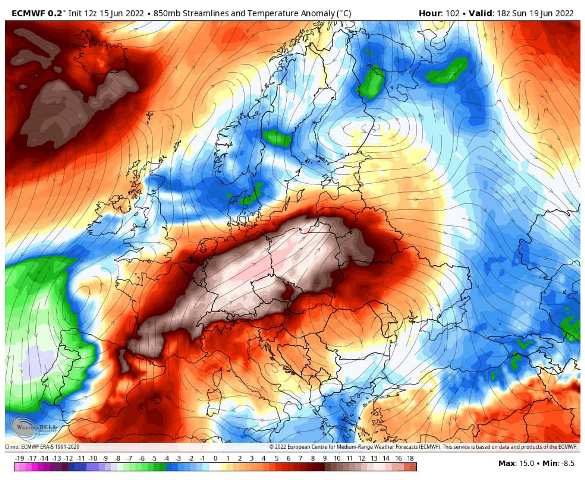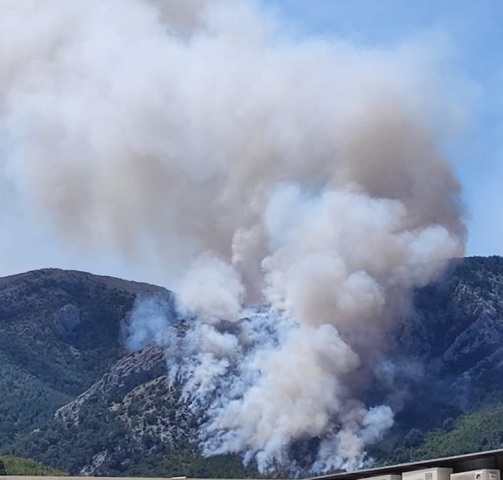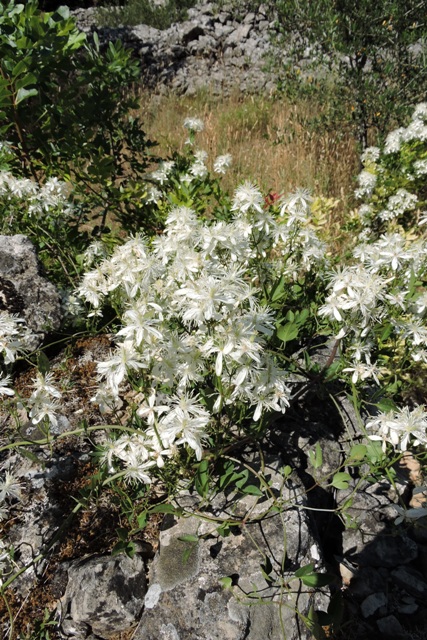Collecting seeds
This week: Deep in the orchard; Collecting seeds; I have raspberries; Out in the afternoon sun;

I need to lay out a hose reel and charge it ready, just in case it is needed.
The weather is hot hot at the moment, after all Tuesday is the northern Summer Solstice.
Granted, this is not the heat which is being experienced across Spain, Portugal, France and into Germany at the moment.

We are on the very southern edge of this heat dome that is tracking north east across Europe.
But with daily high temperatures over 30ºC and everything tinder dry, this is the fire season.
I was reminded of this today when at 12:45 one of the Canadair water bombers growled low overhead. As I looked to the south east, I could see a column of smoke rising from the Pitve area.

A single Canadair means the fire has not grown too big – yet!
When I looked at the Vatrogasci (FRS) Jelsa Facebook page they were reporting responding to the fire, along with my local FRS from Stari Grad and from Grad Hvar.
I’ve been through the Maquis several times this week, but even a walk through the olive groves or a peek over the fence at my next door neighbours untended orchard is enough to tell me that a moment’s carelessness, or just sunlight on a discarded bottle is enough to start a fire.

Fortunately today, the wind is very light so the firefighters were able to get the blaze quickly under control, with the help of the water bomber.
A briefing at 18:00 says the fire is still burning in pockets and firefighters are battling hostile terrain to extinguish everything

However this is both a warning and reminder of how vulnerable we are to fire…
Deep in the orchard
Continuing the work I started last week with the digger in the orchard, I’ve been digging out more of the embankment ready for putting the rockery wall into place.
There is a vertical drop of 65 cm, so after moving the stones away from one of the olives, I rebuilt the three tread stone steps.

It is pleasantly cool at 05:30 however by 10:00 it is too hot to do much outside, when you are in the sun. Consequentally I have been starting early and then finishing in time for coffee.
I am following my tried and tested method of building the steps. This is a “dry” system, with no mortar or concrete.
Having established the level of the first tread, I filled the hole with medium stones, then tamped them into place. This is followed by a layer of small stones, also tamped flat then fine sand to fill any gaps.

I then lay the stone step on to the foundations and make any adjustments, before shuffling it to seat it firmly in place. Using this method provides a very firm foundation for the steps.
Behind the first step I then lay more foundations for the following treads.

Everything I need is close at hand. Digging out with the small bucket on Velika Maška was easy, but when you look at the debris piles, you can see the amount of stone that is in the ground.

Most of this is sandstone, with just an occasional chunk of Limestone.
The soil s very sandy, also indicated by the colour. So separating the debris is not difficult, in this case with a small hand riddle.
Later I will bring the rotary riddle down, and separate everything in bulk, in one go. But for now, just being able to get the small stones to bed in on top of the larger chunks is all I need.
Collecting seeds
I’ve mentioned a couple of times this spring, (Blog 22/19) that I found some Birds Nest orchids by the side of a local path.

I have been keeping an eye on them, to try and make sure that they are protected from being picked, dug up or just run over by a mountain biker.
This week when I did my usual survey of the path, I was delighted to see that the seed pods have dried completely and started to split.

There are just two patches of these orchids, but because the seeds take between five and eight years underground before producing a single flowering stem, I have no idea how many more there are nearby.
As the bottom seed pods had already completely split and spread the seed, I removed the remaining two pods on each stem and manually broadcast the seed a little further away from the dry stems.

This is all in the same immediate area though, because this species of orchid will only grow where there are oak or pine trees close by. They have a symbiotic relationship with Mycelium from the trees, which is essential for them to survive.
I lightly covered the fine seeds with tree litter to protect them.
Orchid seeds are some of the finest seeds in the plant world, often resembling fine powder, so a little protection on top should prevent them being washed away if we get heavy rain.

Now that I know where these orchids are, I will be watching next spring to see if more appear.
However it will be five or more years before I know whether my attempts at conservation have been successful. I do know though that doing nothing is not an option!
While I was out, I also went to collect some seeds from the Cow Vetch, Vicia cracca which I wrote about finding in Blog 22/18.

When I reached the point where I saw the flowers in the spring, I could see that all the lower seed pods had split and ejected their seeds. That means there will be more plants here next year.
Even so I was able to collect a dozen or so seed pods, in a paper envelope.

I reuse the envelopes that the monthly bills come in, to store my seeds.
The paper absorbs any moisture and protects the seeds, plus you can write on the outside what it is that you have kept.
My next decision will be where I am going to plant these, and whether I start them off next spring in individual pots, or just sprinkle some seeds directly onto the soil.
I have raspberries
I was asked some time ago if there was anything which I missed from the UK.
There is just one: fresh, juicy raspberries, straight from the garden, with a big scoop of vanilla ice cream.
I didn’t attempt growing raspberries in Abu Dhabi, it was just TOO hot!
Equally although the supermarkets always had small punnets on the shelf, they had been flown in from California and apart from the air miles involved, were extremely expensive. So I avoided them and bought fruits like locally produced Mango instead.
This week I have been picking raspberries from my canes here in Dol. Nothing unusual in that you may think, that is until you see them.
Raspberry canes thrive in cool, damp temperate climates. Eastern Scotland is known for its Raspberry production.
Dol is the opposite. With little winter cold, almost no spring and summer rain, and hot, drying winds, my attempts at growing different raspberry varieties have been an abject failure.
Buying varieties from mainland garden centres has not been successful, despite all my efforts. The conditions were just not right.
That is except for a single variety I found.

This is Rubus Occidentalis v. Black Jewel.
Originating in the USA, this variety withstands the summer heat here and spreads easily. Everywhere an arching stem touches the soil, a new plant forms.
The flavour is a raspberry, although they look light small blackberries, but that really does not matter. For me, just having fresh raspberries from the orchard is what matters.
Out in the afternoon sun
The problem with my felines is that they love going for walks on the paths and lanes around my home.
Quite how they have become “dog like” in their enjoyment of tearing around orchards, playing hide and seek or just still being kittens and climbing trees, I’m not sure.

The downside to this is that the moment they hear one of the gates open or close, they are there in case they miss a walk. This is so very dog like!
It means that I have to be careful when I go for a long walk, to sneak out unobserved.
When the sun is so hot, their enthusiasm wanes after a few hundred metres and I finish up carrying one or more back home.
I’ve sneaked out a couple of times this week, usually between two and three in the afternoon, when temperatures are at their highest, to check the wild flowers and plants on my selected wild flower survey areas.
We are at the point now where only the deepest rooted plants are still green. There are areas like this section of Garrigue that is now completely brown.

A little further along the path I found some Cactus. This is Prickly Pear cactus, Opuntia ficus-indica.

It is surviving rather than thriving, remaining a low growing succulent, flowering but producing only tiny fruits. This is an example of a species that is just about managing in the conditions of poor, shallow calciferous soils, high heat and little rainfall.
When I lived in Spain there were thickets of Prickly Pear which were a couple of meters tall and the plant was used as a very effective hedge.
A little further along I came across some more of the Smilax thorned climbers. Once again, I have not noticed them on this bit of the path before.
Under the pine trees it was cool and pleasant with a slight breeze. The moment you emerged into the sunlight it was like standing in front of a fan-forced oven as the air temperature was +34ºC.
This past week I have seen but also smelled the Fragrant Clematis, Clematis flammula.

Suddenly at the start of June, great swathes of white will appear climbing over walls and drooping over shrubs. I have a self sown plant climbing through one of my Lilac bushes.

Apart from the wonderful scent which the flowers give off, it can be identified because all the flowers appear from stalks emerging at each leaf joint and of course the Clematis leaves.

On my afternoon walks, I was actually looking for more Orchids, some of the summer varieties. However I wasn’t able to find any.
So after my perambulation I was greeted on my return by four felines at the door with an, “Oh. You’re back. Is it tea time yet?” chorus of meows.
To which the answer is of course, “Yes”… NCG
2 Responses
Brian Homans
So pleased that you have found a raspberry that suits your soil and climate. My favourite fruit but we content ourselves with short drives to our nearest Pick Your Own farm!
Andy Robinson
‘ Grains of flour’ ??..isn’t that an oxymoron or something?…surely flour is a product of grains of wheat…so what is the word?….atom?…grounds?….
Great blog as usual Norman.